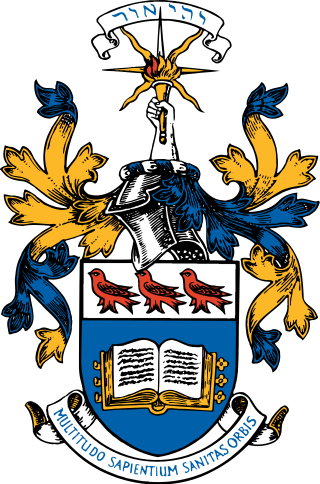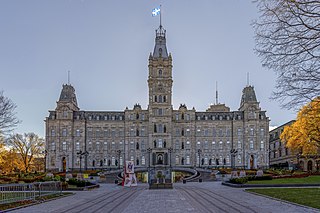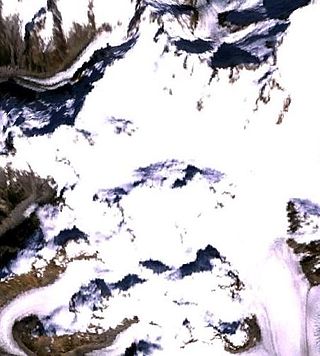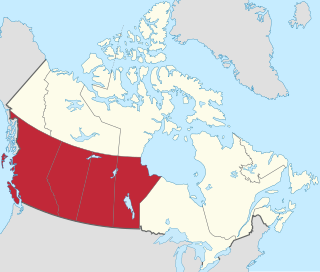
The University of Victoria (UVic) is a public research university located in the municipalities of Oak Bay and Saanich, British Columbia, Canada. Established in 1903 as Victoria College, the institution was initially an affiliated college of McGill University until 1915. From 1921 to 1963, it functioned as an affiliate of the University of British Columbia. In 1963, the institution was reorganized into an independent university.

Vancouver Island is an island in the northeastern Pacific Ocean and part of the Canadian province of British Columbia. The island is 456 km (283 mi) in length, 100 km (62 mi) in width at its widest point, and 32,100 km2 (12,400 sq mi) in total area, while 31,285 km2 (12,079 sq mi) are of land. The island is the largest by area and the most populous along the west coasts of the Americas.

Parliament Hill, colloquially known as The Hill, is an area of Crown land on the southern bank of the Ottawa River in downtown Ottawa, Ontario, Canada. It accommodates a suite of Gothic revival buildings whose architectural elements were chosen to evoke the history of parliamentary democracy. Parliament Hill attracts approximately three million visitors each year. The Parliamentary Protective Service is responsible for law enforcement on Parliament Hill and in the parliamentary precinct, while the National Capital Commission is responsible for maintaining the nine-hectare (22-acre) area of the grounds.

The 1964 Alaskan earthquake, also known as the Great Alaskan earthquake and Good Friday earthquake, occurred at 5:36 pm AKST on Good Friday, March 27. Across south-central Alaska, ground fissures, collapsing structures, and tsunamis resulting from the earthquake caused about 131 deaths.

Events from the year 1872 in Canada.

The Parliament Building of Quebec is an eight-floor structure and is home to the National Assembly of Quebec, in Quebec City, Quebec, Canada. The Parliament Building was designed by architect Eugène-Étienne Taché in a Second Empire style and built between 1877 and 1886, in the heart of Quebec's Parliament Hill. The National Assembly first met there on March 27, 1884, even though the building was only fully completed two years later, on April 8, 1886. From the 1910s to the 1930s, the government built several adjacent buildings to expand its office spaces, creating a parliamentary complex, of which the Parliament Building is the main edifice. This structure is a successor of several earlier buildings, the earliest of which was built in 1620 and among which there were two other parliament houses that served as legislatures.

Patricia Bay is a body of salt water that extends east from Saanich Inlet and forms part of the shoreline of North Saanich, British Columbia. It lies due west of Victoria International Airport. A municipal park covers most of its eastern shore except at the southern end, which is home to a Canadian Coast Guard base, a seaplane port known as Victoria Airport Water Aerodrome, and two Canadian Government research facilities – the Institute of Ocean Sciences and GSC Pacific Sidney.
Women in geology concerns the history and contributions of women to the field of geology. There has been a long history of women in the field, but they have tended to be under-represented. In the era before the eighteenth century, science and geological science had not been as formalized as they would become later. Hence early geologists tended to be informal observers and collectors, whether they were male or female. Notable examples of this period include Hildegard of Bingen who wrote works concerning stones and Barbara Uthmann who supervised her husband's mining operations after his death. Mrs. Uthmann was also a relative of Georg Agricola. In addition to these names varied aristocratic women had scientific collections of rocks or minerals.

The Franklin Glacier Complex is a deeply eroded volcano in the Waddington Range of southwestern British Columbia, Canada. Located about 65 km (40 mi) northeast of Kingcome, this sketchily known complex resides at Franklin Glacier near Mount Waddington. It is over 2,000 m (6,600 ft) in elevation and because of its considerable overall altitude, a large proportion of the complex is covered by glacial ice.

Victoria Harbour is a harbour, seaport, and seaplane airport in the Canadian city of Victoria, British Columbia. It serves as a cruise ship and ferry destination for tourists and visitors to the city and Vancouver Island. It is both a port of entry and an airport of entry for general aviation. Historically it was a shipbuilding and commercial fishing centre. While the Inner Harbour is fully within the City of Victoria, separating the city's downtown on its east side from the Victoria West neighbourhood, the Upper Harbour serves as the boundary between the City of Victoria and the district municipality of Esquimalt. The inner reaches are also bordered by the district of Saanich and the town of View Royal. Victoria is a federal "public harbour" as defined by Transport Canada. Several port facilities in the harbour are overseen and developed by the Greater Victoria Harbour Authority, however the harbour master's position is with Transport Canada.
Haddington Island is a small volcanic island in the Canadian province of British Columbia, located in the Broughton Strait, and separated from Malcolm Island to the north by the Haddington Passage. It is located in the Mount Waddington Regional District.
The Doig Formation is a geologic formation of middle Triassic age in the Western Canadian Sedimentary Basin. It takes the name from Doig River, a tributary of the Beatton River, and was first described in the Texaco N.F.A. Buick Creek No. 7 well by J.H. Armitage in 1962..

Western Canada, also referred to as the Western provinces, Canadian West or the Western provinces of Canada, and commonly known within Canada as the West, is a Canadian region that includes the four western provinces just north of the Canada–United States border namely British Columbia, Alberta, Saskatchewan and Manitoba. The people of the region are often referred to as "Western Canadians" or "Westerners", and though diverse from province to province are largely seen as being collectively distinct from other Canadians along cultural, linguistic, socioeconomic, geographic and political lines. They account for approximately 32% of Canada's total population.

Centennial Square is a plaza in Victoria, British Columbia, Canada. It was built to celebrate the 100th anniversary of the incorporation of the City of Victoria. The Victoria Police Station, city hall and McPherson Playhouse are adjacent to the square. There is a fountain in the square.

The British Columbia Legislature Cenotaph, also known as the Victoria Cenotaph and the War Memorial to the Unknown Soldier, is a war memorial, installed outside the British Columbia Parliament Buildings in Victoria, British Columbia, Canada. Unveiled by Lt.-Gov. W.C. Nichol on July 12, 1925, the granite cenotaph commemorates the sacrifices of Canadian Forces personnel and citizens during both World Wars, the Korean War and peacekeeping missions. The bronze statue was designed by sculptors Vernon and Sidney March.

Front Fountain is a fountain designed by Hooper & Watkins, installed outside the British Columbia Parliament Buildings, in Victoria, British Columbia. It was manufactured in 1905, by Joseph W. Fiske in New York, and installed in 1906. The fountain has one large ceramic tile basin with a granite rim. It once had four basins.

Confederation Garden Court is a plaza in Victoria, British Columbia, completed in 1967 to commemorate the Canadian Centennial of confederation. The plaza features the British Columbia Time Capsule and Confederation Fountain, and is maintained by the Legislative Assembly of British Columbia.

The British Columbia Law Enforcement Memorial is a memorial commemorating law enforcement professionals who died in the line of duty, in Victoria, British Columbia, Canada.

The statue of Queen Victoria is a bronze sculpture depicting Queen Victoria by British artist Albert Bruce-Joy, installed outside the British Columbia Parliament Buildings, in Victoria, British Columbia. The 4-metre (13 ft) statue was commissioned by Richard McBride in 1912, and completed in 1914. World War I delayed the sculpture's unveiling until 1921. The statue was vandalized in 2021.

















